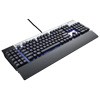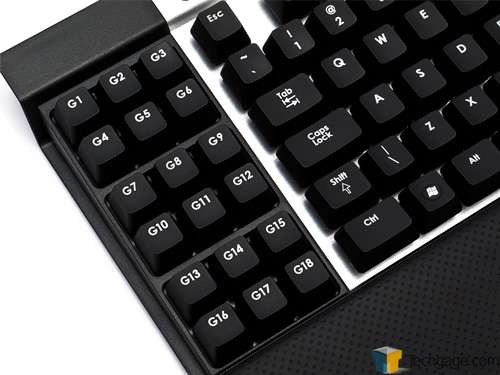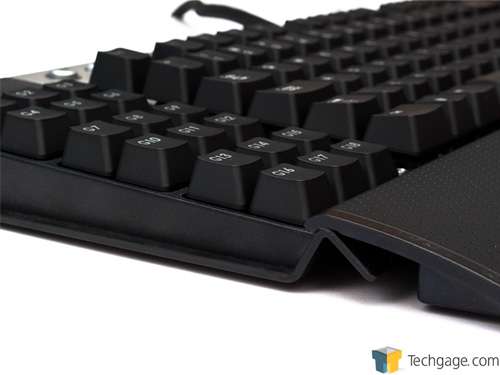- Qualcomm Launches Snapdragon 4 Gen 2 Mobile Platform
- AMD Launches Ryzen PRO 7000 Series Mobile & Desktop Platform
- Intel Launches Sleek Single-Slot Arc Pro A60 Workstation Graphics Card
- NVIDIA Announces Latest Ada Lovelace Additions: GeForce RTX 4060 Ti & RTX 4060
- Maxon Redshift With AMD Radeon GPU Rendering Support Now Available
Corsair Vengeance K90 MMO Keyboard Review

Over the years, Corsair has made us realize just how seriously it takes its products. With the launch of its first Vengeance gaming peripherals, we expected to see a continuation of this top-rate quality, but so far, things have been a little hit or miss – at least with regards to software. Let’s see if anything changes with our look at the K90.
Page 1 – Introduction
Corsair’s K90 under review today is very similar to the K60, but with a few added bells and whistles to make it a little more MMO-friendly. To save repetition, it would be worth reading the original K60 review, as it covers much of the hardware as well as my thoughts on the perks of mechanical keys. This review will concentrate mostly on the software element, plus some of the more unique features of the K90.
The K90 uses a similar template to the K60, but with a few extra buttons on the faceplate for macro and light control (there is backlight support), plus 18 macro keys on the left-hand side. The only other changes are no replaceable keys and no dedicated left-hand ergonomic palm rest, just a full length rest instead.
First, let’s show off some pictures to get an idea of the keyboard. Along the top of the board are five extra keys; four on the left and one next to the Win-lock. The four allow for live macro recording and switching between the different stored profiles. The fifth controls the brightness of the backlight.
Due to the backlight, the keys are made from a semi-opaque plastic that has been coated in black with a space left for the light to pass through the symbol. This does leave me a little concerned as to the longevity of the keys before they become worn, but so far, no issues, despite a couple months of rigorous use. Now stare at the pretty pictures of the backlight in action:
My only real criticism would be the lack of a backlight on the G-Keys, but this complaint extends to all of the silicone dome keys, since none have a backlight. There isn’t a choice of colors either, just brightness. Not a major problem, but this is something the competition has. Also notice that only the top symbol on a key is illuminated (numbers have minimal light, but the symbols are fully lit); this is the result of the switches used.
When keys are pried off, you can see that there is a combined switch and LED. This means all the MX red switches are individually back-lit rather than through an electroluminescent panel through the back of the board.
The main draw of the Corsair K90 comes down to the 18 programmable G-keys on the left side. The software is shared across the entire range of Vengeance peripherals by Corsair, so if you know how to use something like the M60 or M90, then you won’t have any problems here.
The 18 keys are not on the same plane as the rest of the board and are about 7mm or ¼" below the rest of the keys. This is actually well-thought-out given the circumstances to what is a very difficult design choice. When designing a keyboard with lots of extra keys, where do you put them so that they are both easily accessible and won’t interfere with normal use? There is no right answer.
The typical design seen with other boards is to simply put the keys on the sides. The problem then comes with trying to feel for the Ctrl key, then hitting the macro key by mistake. It’s not something you can easily train yourself to get around as the instinctive reaction is to place your fingers in the most bottom-left corner.
The other major difference here is that the G keys use silicone domes instead of mechanical, so they feel different when pushed. It’s not a perfect solution as i still found myself accidentally hitting the bottom row of macros instead of CTRL, but it was uncommon as there is a clear gap and elevation difference.
The rest of the board is pretty much identical to the K60. Media control in the top left corner, silicone domes for the F keys etc, but there’s a full-sized palm rest this time. I’ll also note that even with the backlight, the keyboard will still run on a single USB port and the second is a pass-through.
On the following page, we’ll go over the software and give you our final thoughts.
Support our efforts! With ad revenue at an all-time low for written websites, we're relying more than ever on reader support to help us continue putting so much effort into this type of content. You can support us by becoming a Patron, or by using our Amazon shopping affiliate links listed through our articles. Thanks for your support!












